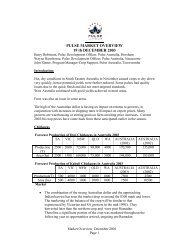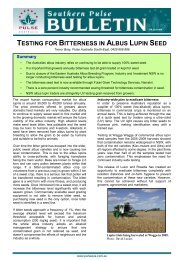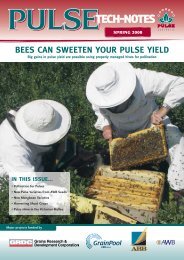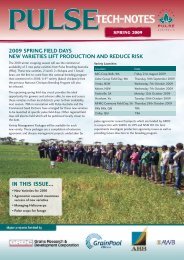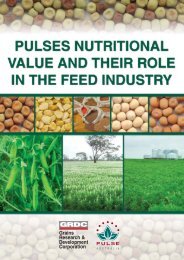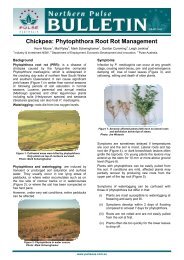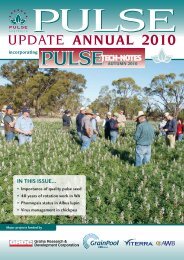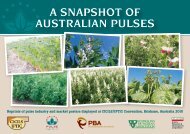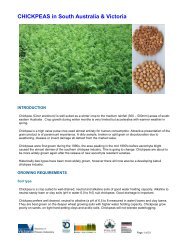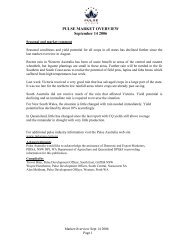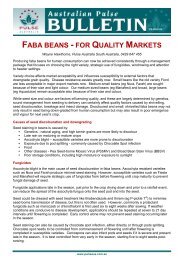Australian Grain Industry Code of Practice - Pulse Australia
Australian Grain Industry Code of Practice - Pulse Australia
Australian Grain Industry Code of Practice - Pulse Australia
Create successful ePaper yourself
Turn your PDF publications into a flip-book with our unique Google optimized e-Paper software.
panel – The Malting and Brewing <strong>Industry</strong> Barley Technical<br />
Committee (MBIBTC).<br />
With the changes in wheat marketing arrangements in <strong>Australia</strong>,<br />
GRDC has established a two tiered system for wheat classification<br />
– the Wheat Classification Council (WCC) to establish grades and<br />
grade requirements and the Variety Classification Panel (VCP) to<br />
grade varieties.<br />
Wheat varietal classification is the categorisation <strong>of</strong> wheat<br />
varieties into grades based on processing and end product quality.<br />
Wheat varietal classification together with wheat grain standards<br />
aims to deliver grain <strong>of</strong> consistent physical quality, processing<br />
performance and end-product quality to customers and end-users<br />
in a differentiated form (grades) allowing exporters (or traders) to<br />
optimise value capture from markets for the benefit <strong>of</strong> industry.<br />
The two key functions required for wheat varietal classification are:<br />
i. establishing the grades i.e. determining the specific make up <strong>of</strong><br />
grades required by end-users and the formulation <strong>of</strong> criteria by<br />
which a variety would be considered to be eligible for a given<br />
grade. These criteria must, and should, evolve in response to<br />
changing market signals (a function <strong>of</strong> the Wheat Classification<br />
Council); and<br />
ii. grading <strong>of</strong> varieties i.e. the technical and objective process for<br />
assessing a variety or proposed variety against a given grade<br />
criteria (a function <strong>of</strong> the Varietal Classification Panel).<br />
In addition to grain quality, there are a number <strong>of</strong> other industry<br />
codes <strong>of</strong> practices that seek to protect product quality and integrity.<br />
These are listed in Part 5.<br />
Chemical residues and product safety<br />
The <strong><strong>Australia</strong>n</strong> grain industry has a range <strong>of</strong> quality assurance and<br />
industry protocols that, combined with a world recognised regulatory<br />
system, underpin buyer confidence in the safety and compliance <strong>of</strong><br />
<strong><strong>Australia</strong>n</strong> grain with market requirements.<br />
This combination <strong>of</strong> industry quality assurance systems and<br />
<strong><strong>Australia</strong>n</strong> Government legislation provide a whole-<strong>of</strong>-chain<br />
approach to food safety, residue management and the provision<br />
<strong>of</strong> grain according to customer requirements. This approach has<br />
proved effective in establishing <strong>Australia</strong> as a creditable producer<br />
and supplier <strong>of</strong> grain commodities. All practices are based on sound<br />
science and are consistent with international policy and standards<br />
for ensuring safe and suitable food.<br />
12<br />
<strong><strong>Australia</strong>n</strong> <strong>Grain</strong> <strong>Industry</strong> <strong>Code</strong> <strong>of</strong> Conduct



